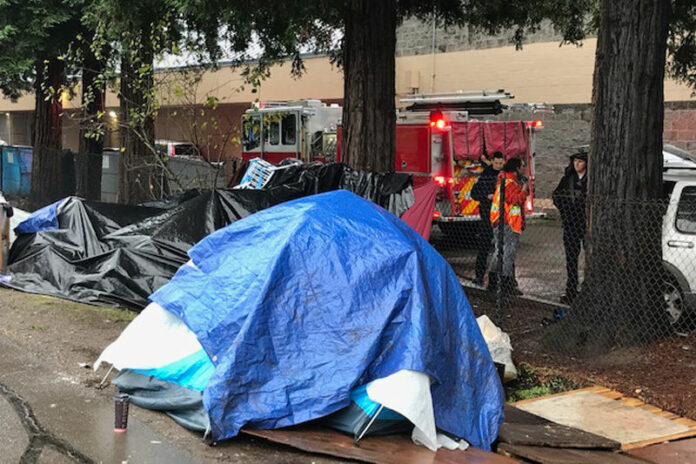Annual homeless count delayed as Grand Jury report is released
The coronavirus pandemic has shifted most of everyone’s attention to public safety and concerns about jobs and livelihoods and away from other issues that were leading the news in pre-pandemic times back in March and before. Chief among those was the county’s homelessness crisis. Even the annual Point-In-Time homeless count was delayed and cut short and, six months later, those important numbers have yet to be reported by the county.
On July 30, the Sonoma County Civil Grand Jury released its annual report that included two investigations into the county’s homeless issue, which they labeled a “crisis.” While saluting county officials’ response to the crisis, the grand jury found numerous faults in cohesive leadership, tracking of expenditures and the lack of a “countywide plan to address future homeless needs and issues.”
A second report dwelled on the more troubling cases of homeless youth associated with persistent drug use, sexual abuse and lack of age-based mental health and social services for the extra-vulnerable population.
Approximately 3,000 county residents are without permanent housing, the grand jury reported based on 2019 official counts. Of this total, two-thirds must sleep in cars, RVs, doorways and outdoor encampments. The county has less than 1,000 temporary or emergency shelter beds, the grand jury found.
There is a lack of urgency or effective response to providing for the shelter and support programs needed to decrease the county’s chronic and emergency homeless population, the grand jury reported. It cited the “immediate and overwhelming” response after the 2017 wildfires that housed fire victims in emergency shelters at the county fairgrounds and elsewhere.
The civil body also found a similar positive response following the 2019 wildfires and floods that resulted in “large-scale evacuations.” And, again, there was a similar response to shelter needs at the outset of the COVID-19 shelter-in-place orders, prompting the jury’s challenge that “the approximately 3,000 homeless residents require a crisis response as well.”
“Multiple plans and policies to ‘solve’ the homelessness crisis have been adopted, with little change in the numbers of people sleeping on the street,” the jury concluded. The Board of Supervisors has responded to the crisis with a “hastily developed plan that committed $12 million” (but) “still lacks a countywide plan to address future needs,” the jury found.
The insecurity of year-to-year federal and state homeless program funding makes long-term planning difficult and the jury is recommending the county develop “a funding source for consistent and predictable funding” and that it “develop a methodology for tracking all costs of homeless services and programs.”
A preliminary homeless report was given to the board of supervisors in early July by Barbie Robinson, executive director of the county’s Department of Health Services and interim director of the county’s Community Development Commission. Her report showed a 7% decline in the homeless population over the previous year, dropping the official county count to 2,745. She credited additional state funding and better local coordination of outreach and critical support services. The report found 562 chronic homeless people, 79 homeless families with children, 657 transition age youth and 139 homeless veterans, a significant decline of 39% from previous years.
The current homeless picture across Sonoma County may differ by statistics, but the daily physical conditions are familiar. With as much as a 1,000 bed and shelter shortage for the vulnerable shelterless population, the incidents of unauthorized encampments persist, as does the routine rousting and removal of the camps as they grow bigger.
The county has added new outdoor-indoor sanctioned camps at Los Guilicos near Kenwood, Santa Rosa’s Finley Park and in Guerneville. There is new state money for Rapid Rehousing Support and nonprofits like the north county’s Reach For Home are developing more “bridge housing.”
Gov. Gavin Newsom has made $600 million available to local governments for the purchase, renovation and management of long-term or permanent housing. The county supervisors are currently considering the purchase of the Sebastopol Inn in downtown Sebastopol and the Hotel Azure in downtown Santa Rosa under this program. The deadline for funding applications was last Friday, Aug. 14.
Last week, the Board of Supervisors voted unanimously to place a quarter-cent sales tax measure on the Nov. 3 ballot to support increased mental health and homeless services. The tax is estimated to raise $25 million annually over the next 10 years for mental health, social services, homeless outreach and behavioral services and some temporary shelter expansions.
A two-thirds voter approval is required and the measure already has drawn the opposition of the Sonoma County Farm Bureau, North Coast Builders Exchange and the North Bay Leadership Council — all groups now opposing all new tax measures on the Nov. 3 ballot.
76.8
F
Healdsburg
April 21, 2025









